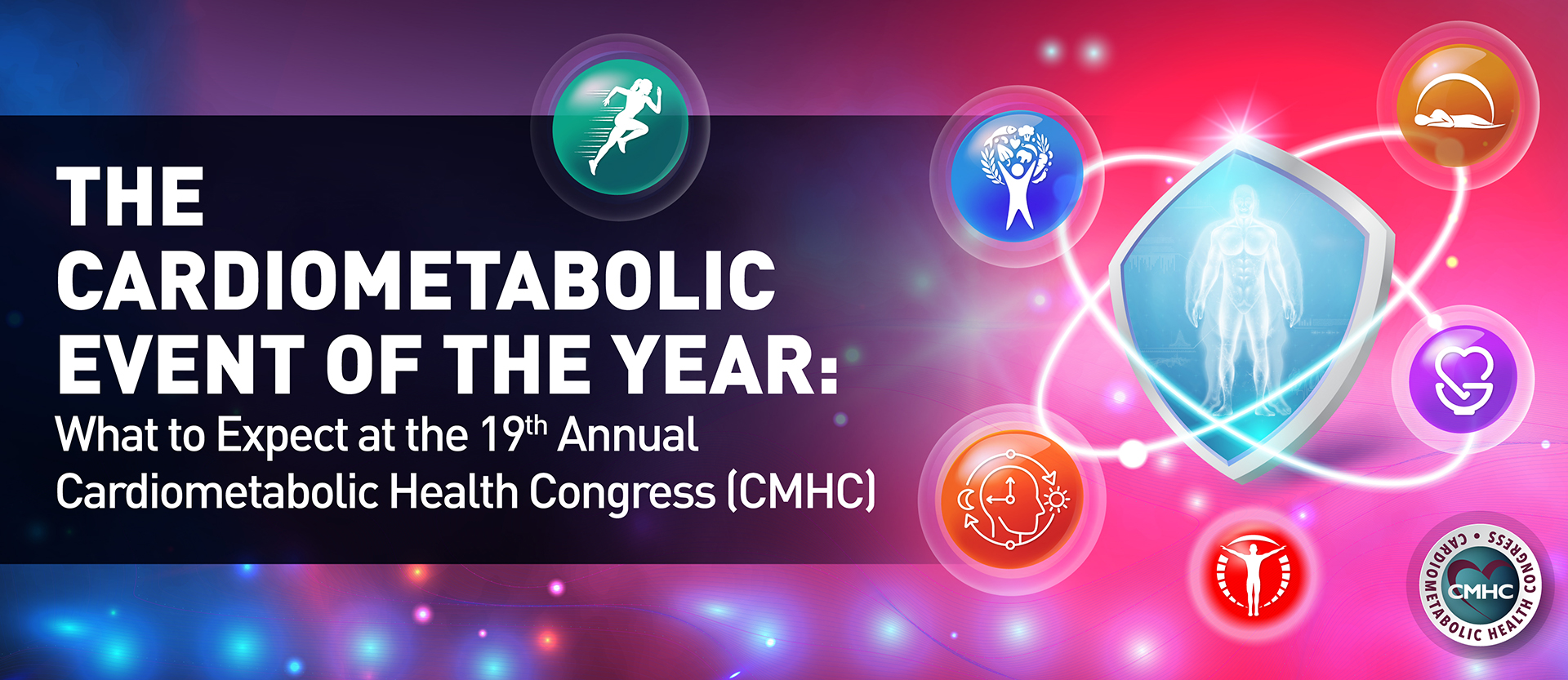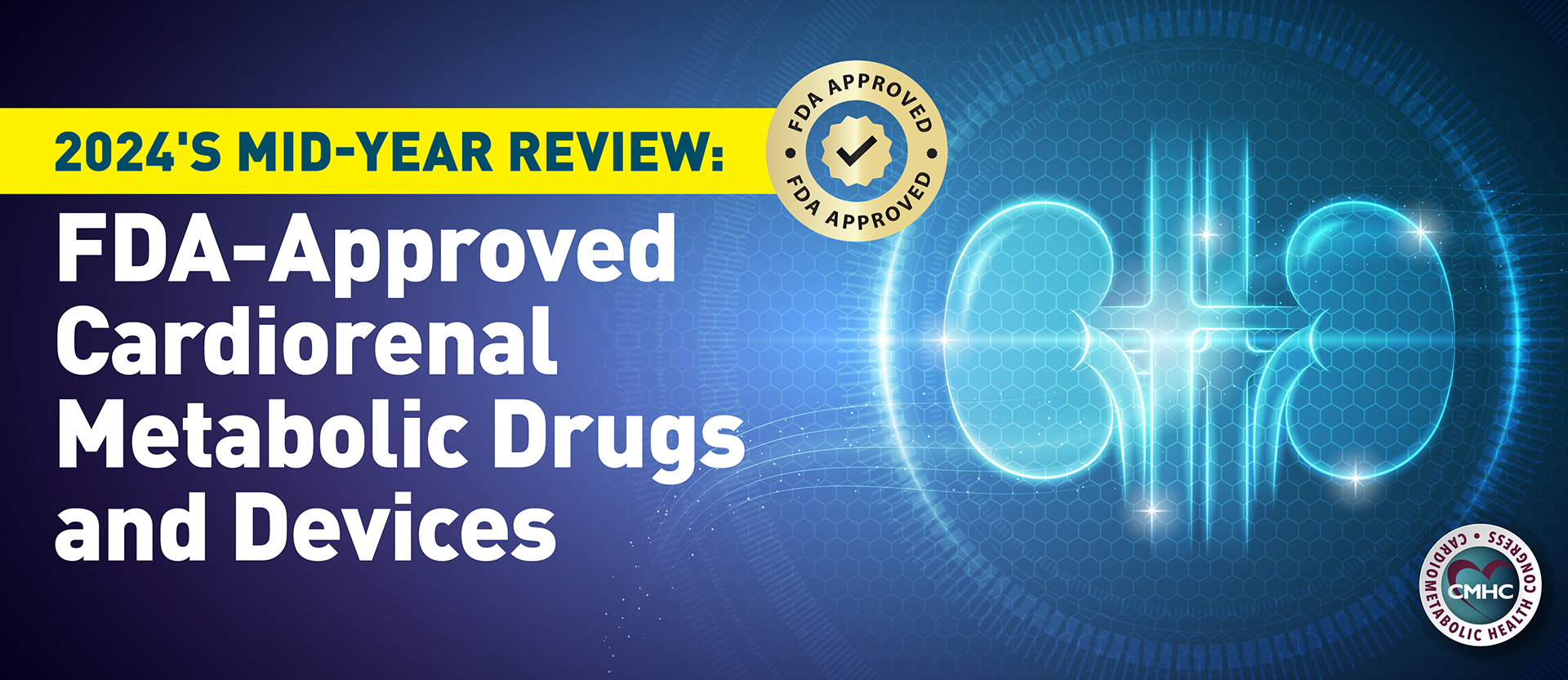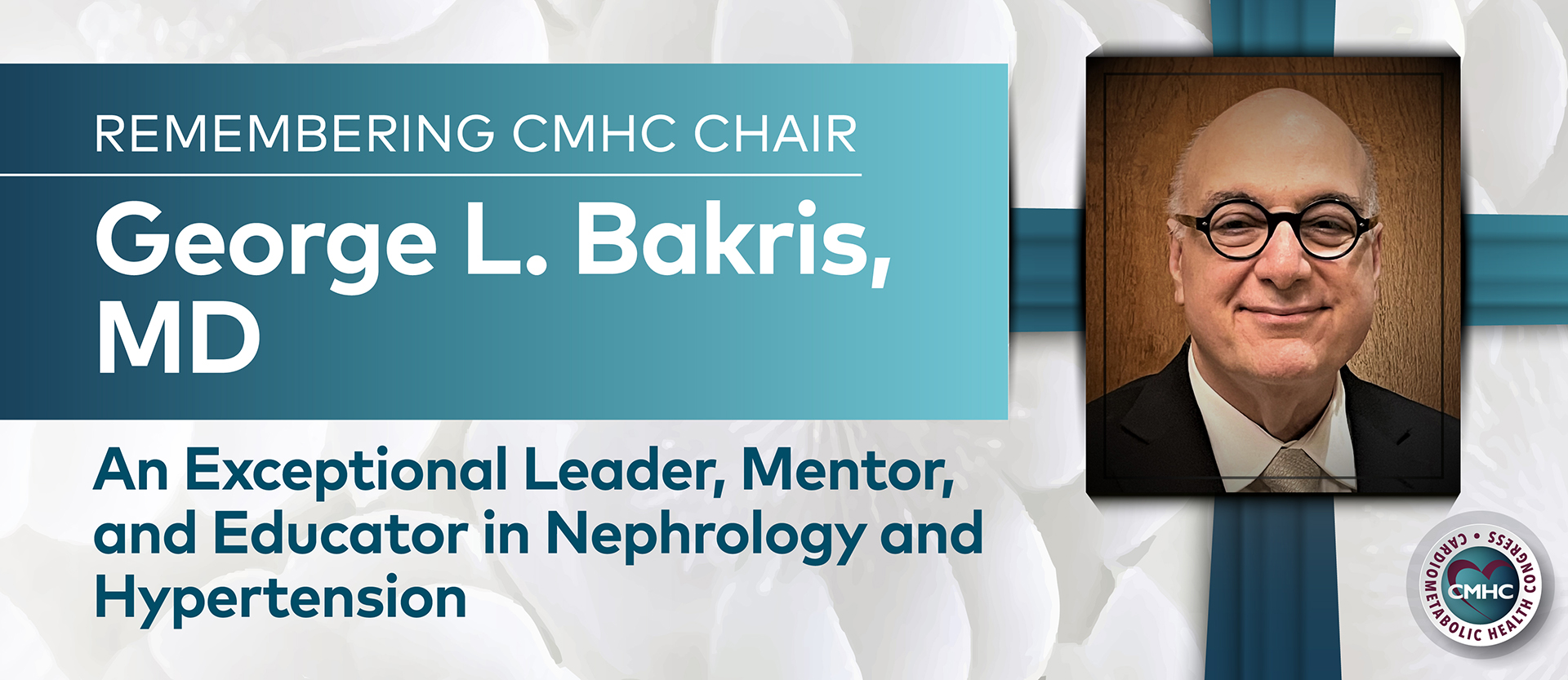CLINICAL BRIEF The Burden of Resistant Hypertension in Women: Novel and Emerging Approaches to Improve Outcomes
This clinical brief was developed from a presentation at the 2023 Women’s Health and Wellness Masterclass held August 2023 in Dana Point, CA. The session, “Resistant Hypertension in Women: Dispelling Common Myths and Recent Clinical Advances,” was presented by Keith C. Ferdinand, MD, supported by an educational grant from Medtronic. It is accredited for up to 0.75 CE/CME credits until 12/06/2024.
Keith C. Ferdinand, MD is a professor of medicine at the Tulane University School of M edicine and longtime diversity and inclusion advocate.

Keith C. Ferdinand, MD
Cardiologist
Introduction
Hypertension is an important cardiovascular disease risk factor that causes more than 7 million deaths worldwide per year, and accounts for 54% of strokes and 47% of coronary heart disease.1 In the US, almost half of the population (45%) have hypertension, and this number is higher in individuals with existing CVD or increased CVD risk, such as in those with diabetes, chronic kidney disease, and older adults.1
Hypertension remains under-treated and difficult to control. Clinicians are challenged with knowing at what blood pressure (BP) level to start medication, at what level to maintain medication, and what medications should be used to get to the BP goal. Despite the improvements in hypertension awareness and treatment, a large proportion of hypertensive adults still fail to achieve their BP targets, despite continuous and persistent therapy.2,3 In particular, individuals who fail to achieve BP targets on 3 antihypertensive medications or require ≥4 medications to achieve their targets are designated as having treatment-resistant hypertension, a condition that poses increased risks for organ damage, morbidity and mortality.2
For these patients, controlling blood pressure is extremely challenging, as options are very limited. Furthermore, there are data to suggest that this is a bigger challenge in women compared to men. Until recently, there was limited information about sex differences in hypertension control and related outcomes, however, studies have shown that even though the prevalence of HTN is similar and women are more likely to be treated with antihypertensive therapy, women are less likely than men to achieve BP control, particularly in aging and older populations.4 It has been suggested that despite having higher rates of resistant HTN, women have lower risk of adverse cardiovascular events, however, this latter part has been disputed by other studies showing the opposite.4-6 These disparities, both in the prevalence of resistant HTN and increased CV risk, are more pronounced in hypertensive women from certain racial and ethnic groups, such as non-Hispanic black women.1,6,7 In addition, BP thresholds at which CVD develops are lower in women compared to men, highlighting the need for stricter BP targets in women.1,8 Furthermore, in addition to conventional risk factors, women also have gender-specific risk factors that can increase the risk of resistant hypertension, such as the use of oral contraceptives, postmenopausal hormone replacement therapy, and history of adverse pregnancy outcomes.2,9
Initial Assessment and Treatment of Patients with Resistant Hypertension
Resistant hypertension is typically defined as BP that remains elevated despite the concurrent use of 3 antihypertensive agents, most commonly being a combination of the following: a long-acting calcium channel blocker (CCB), an angiotensin-converting enzyme (ACE) inhibitor or angiotensin receptor blocker (ARB), and a diuretic.2 Because errors in BP measurement can contribute to the misdiagnosis and suboptimal treatment of hypertension and RH, it is critical to ensure that accurate BP measurements are made before establishing a diagnosis.2 The white-coat effect is important in diagnosing resistant hypertension as some degree of BP rise is seen with in-office measurement in most individuals, but this effect can be greater in individuals diagnosed with hypertension, women, and older individuals.2 Additionally, non-adherence in taking prescribed medications must be evaluated and excluded before true RH is diagnosed, given that as many as 50-80% of hypertensive patients demonstrate suboptimal adherence.2 As discussed above, women can also have sex-specific risk factors for resistant hypertension, in addition to conventional risk factors, and these should be taken into account when getting a comprehensive medical history.2,9
When it comes to the management of RH, lifestyle interventions, including weight loss, dietary salt restriction, and exercise, as well as optimization of current antihypertensive medications are critical.2 In a 2018 statement on RH published by the American Heart Association, a treatment algorithm was released, which involves constant re-evaluations if BP remains elevated and practical steps to continue to address RH.2

Figure 1 – Management of Resistant Hypertension – 2018 AHA Scientific Statement2
Additionally, in 2023, the European Society of Hypertension published new guidelines for the management of HTN, including specific recommendations for the diagnosis and treatment of true resistant hypertension, delineating a simple algorithm for treatment intensification in this setting that now includes renal denervation (Figure 2).10

Figure 2. Treatment for true resistant hypertension – 2023 ESH guidelines10
Emerging pharmacological treatments for resistant hypertension
As part of the cardiovascular outcomes’ trials, several SGLT-2 inhibitors, including canagliflozin, empagliflozin, and dapagliflozin have been shown to decrease blood pressure, however, they are not indicated for BP reduction and additional studies in this area are needed.11 In addition, multiple agents targeting the renin-angiotensin-aldosterone pathway are in advanced clinical development for RH.12 An overview of key evidence with these agents is outlined below.
Several selective nonsteroidal MRAs, such as KBP-5074, esaxerenone, apararenone, and AZD9977 are in development.13-15 Of these, KBP-5074 is at the most advanced stage, currently being evaluated in a phase 3 trial. Phase 2 studies showed that KBP-5074 effectively lowers BP with some risk of hyperkalemia in patients with advanced CKD and uncontrolled blood pressure.16 A phase 3 trial evaluating this agent in patients with uncontrolled hypertension and moderate or severe CKD is ongoing.17
Aprocitentan, a novel dual endothelin-receptor antagonist, was evaluated in a phase III trial (PRECISION trial) for its ability to lower blood pressure when added to other antihypertensive drugs in patents with resistant hypertension.18 The study was recently concluded and the results showed that aprocitentan was well-tolerated and superior to placebo in lowering BP in patients with resistant HTN.19 The study also enrolled a significant proportion of women (41%).19
Baxdrostat, which lowers aldosterone production by blocking aldosterone synthase, was shown to lead to dose-dependent reductions in BP in patients with resistant HTN in the phase 2 BrigHTN study.20 The results of another phase II study, HALO, showed that treatment with baxdrostat did not result in a significant reduction of BP compared to placebo in patients with uncontrolled hypertension.21 However, a larger than expected placebo effect was noted and low adherence was observed in some study sites, which can account for the discrepancies observed between the BrigHTN and HALO trials.21 Despite this, experts remain confident about the viability of this approach and a phase 3 trial is currently being planned. Additionally, lorundrostat (formerly MLS-101), another aldosterone synthase inhibitor, is currently being evaluated in a phase 2 trial for resistant hypertension.22 Recently, results from another phase 2 trial with lorundrostat were published, showing effective BP lowering with treatment vs. placebo in patients with uncontrolled hypertension.23
Another novel approach for resistant hypertension involves using RNA-based therapeutics, such as antisense oligonucleotides (ASOs) and small interfering RNAs (siRNAs).13 Several approaches that fall under this category are in phase 2 trials, including with zilebesiran (RNAi against angiotensinogen) and ION904 (ASO against angiotensinogen).24,25 Results from a phase 1 study with zilebesiran showed dose-dependent decreases in serum angiotensinogen levels and 24-hr ambulatory BP, which were sustained for up to 24 weeks after a single subcutaneous injection of zilebesiran (200mg or more).26
Renal Denervation: Basics and Newer Clinical Data
Several device-based therapies have been studied in RH, however, the one that is more extensively investigated is catheter-based renal sympathetic denervation, which aims to interrupt the activity of afferent and efferent renal sympathetic nerves by applying radiofrequency energy, ultrasound energy, or injection of alcohol in the perivascular space.3
Renal denervation (RDN) first emerged as a potential treatment for RH more than a decade ago, but has recently re-emerged as an alternative for effective blood pressure lowering in these patients.3 Early on, its utility was not fully clear due to conflicting study results, however, recent developments, improved technology and study designs have provided adequate evidence that renal denervation can be an effective treatment option.3,27,28
In 2019, 3 sham-controlled trials, SPYRAL HTN-ON MED, SPYRAL-HTN-OFF MED, and RADIANCE-HTN SOLO, showed that RDN (radiofrequency-based in the SPYRAL trials, and ultrasound energy in the RADIANCE-HTN trial) was effective in reducing blood pressure in patients with RH in the presence or absence of antihypertensive medications.29-31 Additionally, data from the Global SYMPLICITY Registry, which represents the largest real-world study of hypertensive patients receiving RDN, has demonstrated the efficacy and safety of this procedure with significant and sustained office and ambulatory BP reductions in patients with RH for up to 3 years.32,33 Furthermore, these data have also shown the efficacy of RDN in high-risk patients, including those with chronic kidney disease, high cardiovascular risk, diabetes, atrial fibrillation, RH, and in older adults;34,35 with data also suggesting that there is a benefit of RDN in decreasing left ventricular mass, albumin-to-creatinine ratio, and albuminuria in patients with RH.36-38 Based on these data, prediction models have suggested a potential for RDN to reduce the risk of adverse cardiovascular events in high-risk patients, including stroke, all-cause mortality, and MACE, although more studies are needed in this setting.35
Several trials with RDN have been published recently. Data presented at the 2021 American College of Cardiology (ACC) from the RADIANCE-HTN TRIO trial, showed that ultrasound renal denervation reduced blood pressure at 2 months in patients with hypertension and resistant to a standardized triple combination pill.39 Data from the SPYRAL HTN-ON trial showed that renal denervation produced a clinically meaningful and lasting BP reduction up to 36 months of follow-up, independent of concomitant antihypertensive medications and without major safety concerns.40 Additionally, recent topline results from RADIANCE II trial showed that ultrasound renal denervation significantly reduced daytime ambulatory systolic blood pressure when with a sham procedure at 2 months in patients with mild to moderate uncontrolled hypertension.41 Furthermore, data from the SPYRAL HTN-ON MED trial were presented at the 2022 AHA meeting, showing that it met some important secondary endpoints compared to sham controls, such as improvements in office-based systolic blood pressure, as well as meeting its primary safety endpoint, however, the primary efficacy endpoint of a change in 24-hr systolic ambulatory BP monitoring at sixth months was not met.42 More recently, data from the 36-month follow up of the SYMPLICITY study (SIMPLICITY HTN-3) were published, further supporting the efficacy and safety of this procedure, including reductions in mean office and 24-hr BP measurements compared to sham (-22.1 mmHg vs. sham at 36 months with office measurements; -16.5mmHg vs. sham at 36 months with 24-hr ABPM).43
A patient-level analysis of the RADIANCE II, RADIANCE-HTN SOLO, AND RADIANCE-HTN trial trials showed that BP reductions with renal denervation were consistent across HTN severity compared to sham control at 2 months, with consistency across trials.44 In terms of safety, the totality of the studies to date have shown that RDN intervention preserved renal function and re-interventions are rare, with low incidence of renal stenting.27, 45-47
In addition, there have been questions about any sex-related differences in response to renal denervation. A recent expert perspective highlighted that no clear sex-based evidence can be generated due to the under-representation of women in clinical trials, limited data, and lack of pre-specified sex-based analysis, and concluded that more data are needed, including increasing enrollment of women in clinical trials.48
Renal Denervation: Updates to guidelines and position statements
In 2018, the ESC/ESH guidelines for the management of hypertension did not recommend RDN as a routine treatment, citing the need for additional evidence in this setting, and the 2017 US. guidelines do not even mention RDN.49,50 However, recent position statements, such as that from the European Society of Hypertension, as well as from the ESC Council on Hypertension and the European Association of Percutaneous Cardiovascular Interventions (EAPCI) state that RDN is an evidence-based option to treat HTN in addition to lifestyle changes and BP-lowering pharmacotherapy, as it expands the therapeutic options for HTN treatment, is relatively safe, and it is a viable alternative or additive strategy in this setting.27, 51
As mentioned above, the new 2023 ESH guidelines now have included RDN as part of the treatment algorithm for true resistant hypertension (Figure 2).10 They recommend that RDN can be considered as an additional treatment option in patients with resistant hypertension if eGFR >40 ml/min/1.73m2, and patient selection for RDN should be done in a shared decision-making process (Figure 3).10

Figure 3 – Use of renal denervation – 2023 ESH guidelines10
In addition, based on the data listed above, the FDA is evaluating the potential approval of renal denervation for hypertension. In August 2023, there was a meeting of the Circulatory System Devices Panel of the Medical Devices Advisory Committee, which evaluated the data from 2 major RDN devices, the Medtronic and ReCor devices. Based on the data from RADIANCE II, RADIANCE-HTN SOLO and RADIANCE-HTN TRIO, the advisory panel voted to endorse the premarket approval of the Recor device, and voted not to endorse the premarket approval of the Medtronic Symplicity RDN system (on data from SPYRAL HTN-OFF-MED and SPYRAL HTN-ON MED trials).52
Based on this evidence, in November 2023, the ReCor ultrasound RDN device was FDA approved for the treatment of HTN as adjunctive to lifestyle changes and pharmacotherapy. At the time of writing of this document, a final decision on the Medtronic device has not yet been made by the FDA, but updates are expected soon.53
Conclusion
Resistant hypertension is a major challenge and has significant implications for increased cardiovascular risk in women, who are more likely than men to develop resistant hypertension. Conventional hypertension treatment options are often not successful in this setting, and several approaches are currently in development that may help address some of these treatment gaps in the near future. However, additional studies are needed to better inform the potential role of these emerging therapies for the treatment of RH. These treatments will most likely be in addition to current pharmacotherapy, particularly in the case of RDN, which may address the current gaps in pill burden and adherence concerns in difficult to treat patients.54
References:
Tsao, Connie W., et al. “Heart disease and stroke statistics—2023 update: a report from the American Heart Association.” Circulation 147.8 (2023): e93-e621.
Carey, Robert M., et al. “Resistant hypertension: detection, evaluation, and management: a scientific statement from the American Heart Association.” Hypertension 72.5 (2018): e53-e90.
Lauder, Lucas, Michael Böhm, and Felix Mahfoud. “The current status of renal denervation for the treatment of arterial hypertension.” Progress in Cardiovascular Diseases (2021).
Smith, Steven M., et al. “Cardiovascular and mortality risk of apparent resistant hypertension in women with suspected myocardial ischemia: a report from the NHLBI‐sponsored WISE study.” Journal of the American Heart Association 3.1 (2014): e000660.
Hanus, Katarzyna M., et al. “Relationship between gender and clinical characteristics, associated factors, and hypertension treatment in patients with resistant hypertension.” Kardiologia Polska (Polish Heart Journal) 75.5 (2017): 421-431.
Regensteiner, Judith G., and Jane EB Reusch. “Sex differences in cardiovascular consequences of hypertension, obesity, and diabetes: JACC focus seminar 4/7.” Journal of the American College of Cardiology 79.15 (2022): 1492-1505.
Maraboto, Carola, and Keith C. Ferdinand. “Update on hypertension in African-Americans.” Progress in cardiovascular diseases 63.1 (2020): 33-39.
Connelly, Paul J., Gemma Currie, and Christian Delles. “Sex differences in the prevalence, outcomes and management of hypertension.” Current Hypertension Reports 24.6 (2022): 185-192.
Parikh, Nisha I., et al. “Adverse pregnancy outcomes and cardiovascular disease risk: unique opportunities for cardiovascular disease prevention in women: a scientific statement from the American Heart Association.” Circulation 143.18 (2021): e902-e916.
Brunström, M., et al. “2023 ESH Guidelines for the management of arterial hypertension The Task Force for the management of arterial hypertension of the European Society of Hypertension. Endorsed by the International Society of Hypertension (ISH) and the European Renal Association (ERA).” J Hypertension 41 (2023).
Ferdinand, Keith C., Daniel Harrison, and Adedoyin Johnson. “The NEW-HOPE study and emerging therapies for difficult-to-control and resistant hypertension.” Progress in Cardiovascular Diseases 63.1 (2020): 64-73.
Leopold, Jane A., and Julie R. Ingelfinger. “Aldosterone and treatment-resistant hypertension.” New England Journal of Medicine 388.5 (2023): 464-467.
Bakris, George L., Alexandros Briasoulis, and Luke J. Laffin. “Newer Alternatives for Resistant Hypertension-Beyond 2022 Paradigms.” Hellenic Journal of Cardiology (2023).
Blazek, Olivia, and George L. Bakris. “Novel therapies on the horizon of hypertension management.” American Journal of Hypertension 36.2 (2023): 73-81.
Kintscher, Ulrich, George L. Bakris, and Peter Kolkhof. “Novel non‐steroidal mineralocorticoid receptor antagonists in cardiorenal disease.” British Journal of Pharmacology 179.13 (2022): 3220-3234.
Bakris, George, et al. “Effect of KBP-5074 on blood pressure in advanced chronic kidney disease: results of the BLOCK-CKD study.” Hypertension 78.1 (2021): 74-81.
ClinicalTrials.gov, NCT04968184. “Efficacy and safety of KBP-5074 in uncontrolled hypertension and moderate or severe CKD (Clarion-CKD).” Available at https://clinicaltrials.gov/study/NCT04968184, accessed November 1, 2023.
Danaietash, Parisa, et al. “Identifying and treating resistant hypertension in PRECISION: A randomized long‐term clinical trial with aprocitentan.” The Journal of Clinical Hypertension 24.7 (2022): 804-813.
Schlaich, Markus P., et al. “Dual endothelin antagonist aprocitentan for resistant hypertension (PRECISION): a multicentre, blinded, randomised, parallel-group, phase 3 trial.” The Lancet 400.10367 (2022): 1927-1937.
Freeman, Mason W., et al. “Phase 2 trial of baxdrostat for treatment-resistant hypertension.” New England Journal of Medicine (2022).
ACC (American College of Cardiology). “Efficacy and safety of baxdrostat in patients with uncontrolled hypertension – HALO.” March 4, 2023. Available at https://www.acc.org/latest-in-cardiology/clinical-trials/2023/03/01/23/34/halo, accessed November 1, 2023.
ClinicalTrials.gov, NCT05769608. “A pivotal study to evaluate the efficacy of lorundrostat in subjects with uncontrolled hypertension on a standardized antihypertensive medication regimen.” Available at https://clinicaltrials.gov/ct2/show/NCT05769608, accessed November 1, 2023.
Laffin, Luke J., et al. “Aldosterone synthase inhibition with lorundrostat for uncontrolled hypertension: the Target-HTN randomized clinical trial.” JAMA 330.12 (2023): 1140-1150.
ClinicalTrials.gov, NCT05103332. “Zilbesiran as add-on therapy in patients with hypertension not adequately controlled by a standard of care antihypertensive medication (KARDIA-2).” Available at https://clinicaltrials.gov/ct2/show/NCT05103332, accessed November 1, 2023.
ClinicalTrials.gov, NCT05314439. “A study to assess the safety, tolerability, and efficacy of monthly subcutaneous administration of ION904 in participants with uncontrolled hypertension.” Available at https://clinicaltrials.gov/ct2/show/NCT05314439, accessed November 1, 2023.
Desai, Akshay S., et al. “Zilebesiran, an RNA interference therapeutic agent for hypertension.” New England Journal of Medicine 389.3 (2023): 228-238.
Barbato, Emanuele, et al. “Renal denervation in the management of hypertension in adults. A clinical consensus statement of the ESC Council on Hypertension and the European Association of Percutaneous Cardiovascular Interventions (EAPCI).” European Heart Journal 44.15 (2023): 1313-1330.
Lim, Gregory B. “Resurgence of renal denervation for resistant hypertension.” Nature Reviews Cardiology (2021): 1-1.
Azizi, Michel, et al. “Endovascular ultrasound renal denervation to treat hypertension (RADIANCE-HTN SOLO): a multicentre, international, single-blind, randomised, sham-controlled trial.” The Lancet 391.10137 (2018): 2335-2345.
Böhm, Michael, et al. “Efficacy of catheter-based renal denervation in the absence of antihypertensive medications (SPYRAL HTN-OFF MED Pivotal): a multicentre, randomised, sham-controlled trial.” The Lancet 395.10234 (2020): 1444-1451.
Silverwatch, Jonathan, et al. “Renal Denervation for Uncontrolled and Resistant Hypertension: Systematic Review and Network Meta-Analysis of Randomized Trials.” Journal of clinical medicine 10.4 (2021): 782.
Mahfoud, Felix, et al. “Effects of renal denervation on kidney function and long-term outcomes: 3-year follow-up from the Global SYMPLICITY Registry.” European Heart Journal 40.42 (2019): 3474-3482.
Mahfoud, Felix, et al. “Global SYMPLICITY Registry” Presented at EuroPCR 2021, May 2021.
Mahfoud, Felix, et al. “Renal denervation in high-risk patients with hypertension.” Journal of the American College of Cardiology 75.23 (2020): 2879-2888.
Pietzsch, Jan, et al. “CLINICAL EVENT REDUCTIONS IN HIGH-RISK HYPERTENSION PATIENTS TREATED WITH RENAL DENERVATION: A MODEL-BASED ESTIMATE BASED ON 36-MONTH DATA FROM THE GLOBAL SYMPLICITY REGISTRY.” Journal of the American College of Cardiology 77.18_Supplement_1 (2021): 1644-1644.
de Sousa Almeida, Manuel, et al. “Impact of renal sympathetic denervation on left ventricular structure and function at 1-year follow-up.” PLoS One 11.3 (2016): e0149855.
Ott, Christian, et al. “Improvement of albuminuria after renal denervation.” International journal of cardiology 173.2 (2014): 311-315.
Sousa, Henrique, et al. “Changes in albumin-to-creatinine ratio at 12-month follow-up in patients undergoing renal denervation.” Revista portuguesa de cardiologia 36.5 (2017): 343-351.
Azizi, Michel, et al. “Ultrasound renal denervation for hypertension resistant to a triple medication pill (RADIANCE-HTN TRIO): a randomised, multicentre, single-blind, sham-controlled trial.” The Lancet (2021).
Mahfoud, Felix, et al. “Long-term efficacy and safety of renal denervation in the presence of antihypertensive drugs (SPYRAL HTN-ON MED): a randomised, sham-controlled trial.” The Lancet 399.10333 (2022): 1401-1410.
tctMD. “RADIANCE II confirms ultrasound-based renal denervation lowers BP.” September 18, 2022. Available at https://www.tctmd.com/news/radiance-ii-confirms-ultrasound-based-renal-denervation-lowers-bp, accessed November 9, 2023.
American College of Cardiology News Story. “SPYRAL-HTN-ON-MED: renal denervation in the presence of anti0hypertensive medications.” November 7, 2022. Available at https://www.acc.org/latest-in-cardiology/articles/2022/11/01/22/00/mon-5pm-spyral-htn-on-aha-2022, accessed January 30, 2023.
Bhatt, Deepak L., et al. “Long-term outcomes after catheter-based renal artery denervation for resistant hypertension: final follow-up of the randomised SYMPLICITY HTN-3 Trial.” The Lancet 400.10361 (2022): 1405-1416.
Kirtane, Ajay J., et al. “Patient-level pooled analysis of ultrasound renal denervation in the sham-controlled RADIANCE II, RADIANCE-HTN SOLO, and RADIANCE-HTN TRIO trials.” JAMA cardiology 8.5 (2023): 464-473.
Sanders, Margreet F., et al. “Renal safety of catheter-based renal denervation: systematic review and meta-analysis.” Nephrology Dialysis Transplantation 32.9 (2017): 1440-1447.
Sardar, Partha, et al. “Sham-controlled randomized trials of catheter-based renal denervation in patients with hypertension.” Journal of the American College of Cardiology 73.13 (2019): 1633-1642.
Townsend, Raymond R., et al. “Incidence of renal artery damage following percutaneous renal denervation with radio frequency renal artery ablation systems: Review and Meta-Analysis of published reports.” EuroIntervention: journal of EuroPCR in collaboration with the Working Group on Interventional Cardiology of the European Society of Cardiology (2020).
Dakhil Z and Al Raisi S. “Is there a sex-related difference in response to renal denervation?” Cardiac Interventions Today Cardiac Interventions Today, Women’s Heart Health. 17(1) January/February 2023, available at https://citoday.com/articles/2023-jan-feb/is-there-a-sex-related-difference-in-response-to-renal-denervation, accessed November 1, 2023.
Whelton, Paul K., et al. “2017 ACC/AHA/AAPA/ABC/ACPM/AGS/APhA/ASH/ASPC/NMA/PCNA guideline for the prevention, detection, evaluation, and management of high blood pressure in adults: a report of the American College of Cardiology/American Heart Association Task Force on Clinical Practice Guidelines.” Journal of the American College of Cardiology 71.19 (2018): e127-e248.
Williams, Bryan, et al. “2018 ESC/ESH Guidelines for the management of arterial hypertension: The Task Force for the management of arterial hypertension of the European Society of Cardiology (ESC) and the European Society of Hypertension (ESH).” European heart journal 39.33 (2018): 3021-3104.
Schmieder, Roland E., et al. “European Society of Hypertension position paper on renal denervation 2021.” Journal of Hypertension 39.9 (2021): 1733-1741.
FDA Advisory Meeting, August 22-23, 2023. “Circulatory system devices panel of the medical devices advisory committee meeting announcement.” Available at https://www.fda.gov/advisory-committees/advisory-committee-calendar/august-22-23-2023-circulatory-system-devices-panel-medical-devices-advisory-committee-meeting, accessed November 1, 2023.
Jeffrey, Susan. “FDA Oks Paradise renal denervation system for hypertension.” Medscape, November 8, 2023. Available at https://www.medscape.com/viewarticle/998237, accessed November 9, 2023.
Ferdinand, Keith C. “Hypertension and resistant hypertension in women: dispelling misconceptions.” Talk delivered at 2023 CMHC’s Women’s Health Masterclass, August 18, 2023, Dana Point, CA.
















